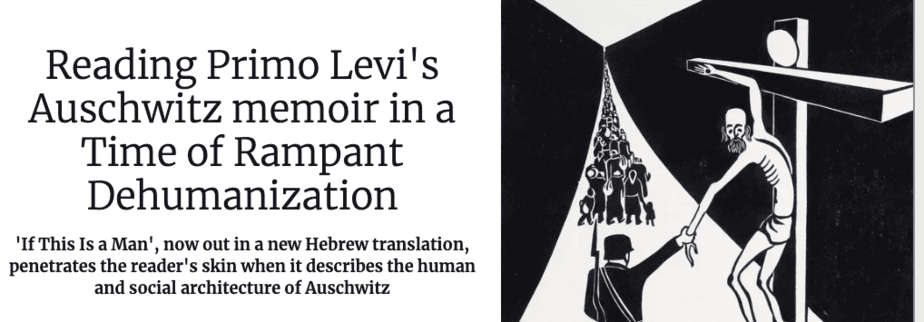Reading Primo Levi’s Auschwitz memoir in a Time of Rampant Dehumanization

Primo Levi began writing “If This Is a Man” in December 1945, immediately after his return to Turin, Italy from Auschwitz, out of what he called, in his preface to the book, an “immediate and violent impulse.” The writing of it began with the final chapter, which deals with the 10 days between the departure of the Nazis and the arrival of the Russians. He was in the camp hospital with scarlet fever (and therefore was not included in the death march in which almost all the other prisoners perished or were murdered). In the following 11 months, the remaining chapters of the book were completed.
The Einaudi publishing house rejected the manuscript; the author Natalia Ginzburg, who worked as a reader at the Italian publisher, told Levi there were “too many books about the Nazi camp.” The book, Levi’s first, was published by a small publisher; much of the first print run went unsold. In 1958, Einaudi published a new edition of the book, which began its slow and persistent journey until, in the 1980s, it was recognized as one of the most important works written about the Holocaust.
Levi continued to work as a chemist, and to write. His second book, “The Truce” (titled “The Reawakening” in the United States) dealt with his journey home from the camp; later he also published poetry, essays, novels and short stories, including science fiction stories. A long and interesting afterword by Menakhem Perry, the editor of the new Hebrew translation, offers a literary analysis of Levi’s life and death through his writing, all of which is related, directly or indirectly, to his experiences in Auschwitz. Levi died in April 1987 as a result of a fall from the third floor in the stairwell of his home in Turin; the question of whether it was an accident or suicide continues to preoccupy his readers and commentators to this day. (Perry believes that it was something in between, a kind of spontaneous suicide, the reasons for which are many and contradictory.)
For the new edition, which was translated from Italian by Meron Rapoport, the book’s original name was restored, rightly. In the 1988 Hebrew edition (translated by Itzhak Garti, published by Am Oved), the title was changed to “Is This a Man?” – full of reproach. “If This Is a Man” is a more open title. It relates to Auschwitz as something that took place not “on another planet,” but rather in our human reality, and in whose light we must understand ourselves from now on: If this is a man, what does this mean for the world we have built and the life we live today? And what is the point of grappling with this meaning? It is more in keeping with the spirit of Levi, whose spare writing style, which is enigmatic and open to conflicting interpretations, hides great complexity.
It is thanks to this complexity that Levi is also so appropriate for this moment, in which the growing presence of the Holocaust in our lives, as an image and as political currency, makes dealing with it complicated, fluid and elusive. “If This Is a Man” felt relevant to me not in the narrow sense of “the lessons of the Holocaust,” but rather in an emotional way, against the background of October 7 and the war in Gaza, when the abstract and the concrete horror is most flagrantly present in our daily lives. The consolation and the hope that Levi offers are not that of “We survived Pharaoh, we shall survive this too.” Rather, they derive from a combination of digging deeper, a sense of responsibility and inner honesty in the face of the horror. These too, the book reminds us, are a part of man.
הסופר פרימו לוי
Italian writer Primo Levi in Turin, 1981.Credit: Sergio del Grande/Mondadori via Getty Images
Unrelenting struggle for survival
“If This Is a Man” begins with Levi’s arrest in Italy and ends with the liberation of Auschwitz. Levi was 24 when he was captured by the Fascist militia and sent to the Fossoli internment camp, which held hundreds of other Jews, mostly entire families. “It was my good fortune to be deported to Auschwitz only in 1944” – these are the first words in the book, and they already evoke bewilderment. What does good fortune have to do with a death camp? The literal meaning is that Levi was not sent to Birkenau but rather to Auschwitz III, whose prisoners the Germans wanted to exploit for slave labor rather than killing them immediately. It was also Levi’s good fortune that his professional qualifications as a chemist allowed him to secure, several months after his arrival, a job in a heated laboratory, thanks to which he survived. Added to this are Levi’s statements that it was his time in Auschwitz that gave his life purpose – statements that leave something mysterious and inaccessible in his character for us, the readers.
Primo Levi’s words echo across the daily routine of Israelis and Palestinians
Why was the Libyan Holocaust taken out of Primo Levi’s influential book in Israel?
When Words Failed the Great Primo Levi
Already in the description of the last night in the internment camp in Italy, readers are struck by the stunning power of the book. It is clear to all of the people who are being deported with Levi that they are being sent to their deaths; he writes about the terrible hours they spent with a matter-of-fact simplicity and with discretion, which protects the dignity and humanity of those who will soon be murdered: “Many things were then said and done among us; but of these it is better that there remain no memory.” He describes the mothers who pack toys and pillows for their children and prepare food for the journey, but avoids disclosing his emotions, until “Dawn came on us like a betrayer; it seemed as though the new sun rose as an ally of our enemies to assist in our destruction.”
It is the lacunae and a certain detachment that give the text its staggering power. In his 1986 book, “The Drowned and the Saved,” a collection of essays, Levi returns to those experiences in a more reflexive manner that relates to the writing of “If This Is a Man” and to the reactions it received. The later text, explicit and analytical, is fascinating but it does not get under one’s skin the way “If This Is a Man” does.
In Auschwitz, Levi was placed in a subcamp, Auschwitz III-Monowitz, owned by the I.G. Farben chemical company and meant to provide slave labor for its synthetic-rubber factory. The vast majority of its 12,000 prisoners were Jews. Alongside them were also political prisoners and criminals, who often served in different positions in the camp and therefore tended to survive longer. Jewish prisoners survived an average of three months at the camp; most of the deaths were due to the hard labor and the poor food. Occasionally there were selections; prisoners judged unfit for work were either taken to the camp’s hospital and given a lethal injection or sent to the gas chambers in Birkenau.
“If This Is a Man” devotes the most attention to the human and social architecture of the concentration camp. Readers who aren’t familiar with the book may think that its title – certainly that of the old Hebrew version – refers to the Nazis, questioning whether they were humans at all?
The SS members, however, hardly appear in the text, whose main interest is in the middle ranks: functionaries, capos, annexed citizens and the ordinary prisoners known as Haftling (detainees).
For Levi, the last ones were those who had truly lost their humanity, since it was among them that no solidarity nor brotherhood could be found, but rather a war of all against all in which everyone stole from each other, hiding and cheating, and no acts of kindness could be found. Levi describes this as a relentless struggle for survival as everyone is left desperately and cruelly alone.
Morality, good and bad, the just and the unjust, family, friendship, the brotherhood of Jewish destiny, longing for the past or hopes for the future – all belonged to the world of those who are outside the camp. The Haftling considered these as a burden as anyone who held on to hope or nostalgia was a little bit closer to death.
Psychiatrist Viktor Frankl, who survived the concentration camps and even stayed in Auschwitz, and who wrote “Man’s Search for Meaning,” believed that moral categories – primarily good and evil – were preserved in the camp, and that belief in the possibility of a future was a necessary (but not sufficient) condition for survival.
Levi’s approach is darker. He identifies two other groups in the camp: the drowned and the saved. The saved are the ones who developed all kinds of survival and coping techniques, each person with their own particular methods. They were not better individuals – many times just the opposite. A vast majority of them died, but their struggle grants them a name, a face and a character, making them human again.
Levi emphasizes that the Hobbesian existence in the camp wasn’t a kind of natural state that exposed the true nature of mankind, but rather its opposite. This was achieved through well-planned means such as humiliations, bizarre rituals and laws, unnecessary labor (the factory didn’t produce a kilogram of rubber until the war ended) and the insignificance of death.
These were used to turn a man into a non-human, thereby enabling and justifying not only his destruction but also the voluntary blindness and lack of compassion that characterized Germans who didn’t participate in the actual acts of murder.
עטיפות ספרים
The book jacket for the new Israeli edition of ” Primo Levi’s “If This is a Man.”Credit: New Library
Levi describes all of these in detail, although he keeps his distance, directly depicting very little of the horrors and he does this almost without writing about death. This is because even the right to a meaningful death was taken away from the prisoners.
In Levi’s story, prisoners don’t really die but simply fade away and disappear (an exceptional scene is the description of the public hanging of a prisoner who helped the Sonderkommando revolt in Birkenau. The very fact that the punishment was ritualized, reestablished the rebel’s humanity).
An ominous sign
Even while still in Auschwitz, Levi was haunted by a dream in which he told the camp’s story, but no one believed him. The urge to describe what happened there continued to haunt him throughout his life.
In a characteristic twist, however, Levi suddenly wonders if it’s worthwhile and whether there’s any good in keeping any memory of this unusual human condition.
This is Levi’s appeal to the readers: What is the nature of the connection between us, who live comfortable lives, and those people who were stripped of their humanity in Auschwitz? The paradoxical answer is that there isn’t such a connection, but that we must establish it in our writing, thinking and acting.
This isn’t only what we owe to the Haftling, but also to the future. He believed that the Holocaust was made possible by unique circumstances that may not recur, but its fundamental causes, and chief among them is the thought that “every foreigner is an enemy” – a “conviction that lies buried in the mind like some latent infection” – can lead and will lead to the separation of humanity from man, and, eventually, to genocide. Therefore, Levi claimed that we all must understand the story of the extermination camps as an ominous sign.
Levi’s descriptions and warnings made him one of the most quoted personalities concerning human rights and the protection of minorities. The idea that every person has absolute rights originated hundreds of years ago, but the attempt to enforce it comprehensively and globally was a direct result of World War II.
In 1948, the United Nations adopted the Convention on the Prevention and Punishment of the Crime of Genocide, which imposes on the 152 signatories an obligation to act; the International Court of Justice in The Hague was founded in 1945 and in 2002 the International Criminal Court was founded.
Chapter VII of the United Nations Charter allows the organization’s Security Council to impose sanctions and even order military intervention in a country’s internal affairs. It was on this article’s basis that the UN Security Council approved in 2011 the strike on the Gadhafi regime in Libya.
However, as Hannah Arendt observed in 1951, “No paradox of contemporary politics is filled with more poignant irony than the discrepancy between the efforts of well-meaning idealists who stubbornly insist on regarding as ‘inalienable’ those human rights which are enjoyed only by the citizens of the most prosperous and civilized countries, and the situation of the rightless themselves” (“The Origins of Totalitarianism”).
These assertions have kept resonating with increasing intensity ever since. Arendt and Levi did not live to see the massacre of 8,000 Bosnian men and boys in Srebrenica in 1995, the genocide committed by the Rwandan government against the Tutsis in 1994 (which was done at a speed that even the Nazis’ atrocities didn’t match, as close to a million people were murdered in only three months) and the half million civilians that Bashar Assad systematically and deliberately killed in the Syrian civil war.
The explanation that Arendt offered regarding the “banality of evil” – which is used by director Jonathan Glazer to describe the character of Auschwitz commander Rudolf Hoss in his new movie “The Zone of Interest” – seems limited when considering all these examples.
To the mediocre bureaucrat who becomes a modern mass murderer were added the careerist, the opportunist, those who did their job enthusiastically and out of ingenuity, the ideologists, the sadists and the religious fanatics.
In retrospect, Arendt’s Eichmann and Glazer’s Hoss appear – much as the entire Nazi extermination machine – primarily as German products; other countries simply do it differently. On the other hand, Levi’s description of the concentration camp – with all of its infinite and absurd complexity, its different types, the internal hierarchies, the rigid legality, the chaos and arbitrariness on its side – evokes a feeling of much greater closeness to our world.
Precisely in the face of what we perceive today as absolute evil, Levi avoided the simplistic division into good and evil. Every act and every human behavior has a context that we must understand. But the context doesn’t absolve the person from responsibility or exempt the Nazis from hanging.
פרימו לוי
Primo Levi sitting at a desk in his study in Turin, 1981Credit: Sergio del Grande\Mondadori Portfolio\Mondadori via Getty Images
In “The Drowned and the Saved,” Levi wrote that “Anyone who has sufficient experience of human affairs knows that the distinction … good faith/bad faith is optimistic and illuminist. … It presupposes a mental clarity which few have, and which even these few immediately lose when, for whatever reason, past or present reality arouses anxiety or discomfort in them.”
According to Levi, the belief that our actions are always done in good faith, and that the other or the enemy always acts with malice, is what allows the necessary dehumanization that leads to murder. This is why resisting murder must begin by insisting on complexity, context and on all the good and bad within all human beings.
Levi opposed ascribing collective guilt on the Germans and used to correspond with German readers who wrote to him. He was also, however, frustrated by the former’s evasion of responsibility and refused to grant them the forgiveness they requested.
Obliged to compare
The Hamas attack of October 7 and the war in the Gaza Strip evoked the image of the Holocaust on both sides. The descriptions of children in Gaza border kibbutzim, hiding from Hamas killers in closets and under beds raised these connotations even among those who shy away from such vulgar acts as the wearing of the yellow Star of David by the Israeli delegation to the UN.
On the other hand, the mass destruction in Gaza City, the killing of more than 30,000 people and the starvation of hundreds of thousands in the Strip led to Israel being accused of genocide. When you add to these the murderous Arab-hating calls and fantasies of politicians and journalists, one supposedly gets the damning combination of intention and deed.
The rational response to these analogies is that we’re better off without them: No one side is a Nazi and no one is a Haftling. Israel isn’t systematically exterminating the Palestinians like the Nazis did to the Jews, we Israelis aren’t helpless prisoners and Hamas isn’t an existential threat.
In other words, there’s no place for that comparison. However, reading “If This Is a Man” at this moment also leads to another perspective, at the center of which is the dehumanization of the other that both societies have reached, and the dangers it unleashes.
The Lager, or Nazi camp, is always at the end of the chain, writes Levi. That’s why it’s so appropriate that this book has now been republished. Contrary to the Pavlovian claim that one should never compare, Levi stresses that – on the contrary – we are always obliged to compare.
“If This Is a Man” by Primo Levi, translated into Hebrew by Meron Rapoport, edited by Menakhem Perry. The New Library, Siman-Kria Books. Hakibbutz Hameuchad Publishing House. 271 pages.


